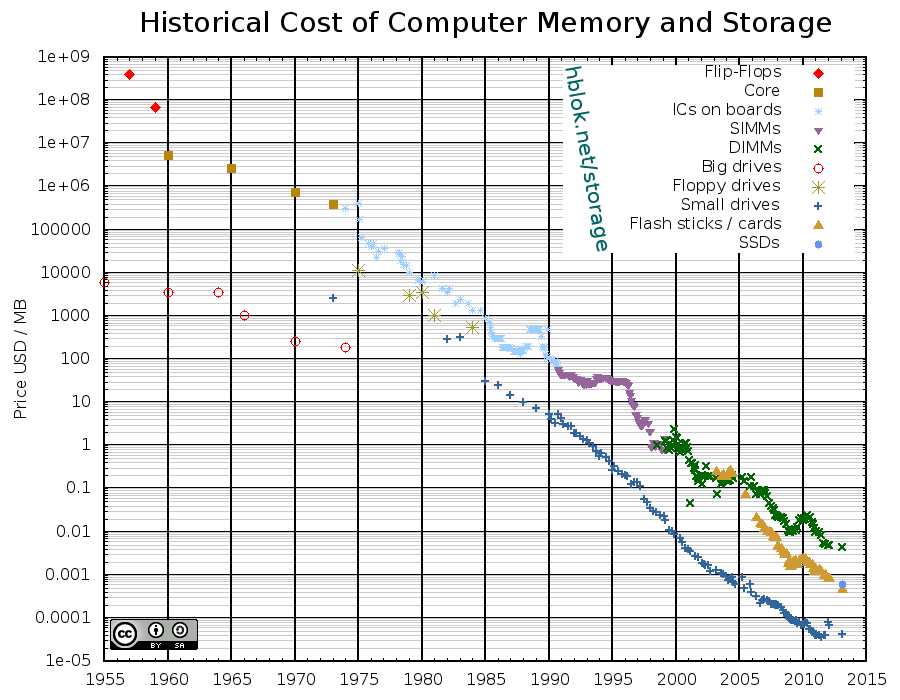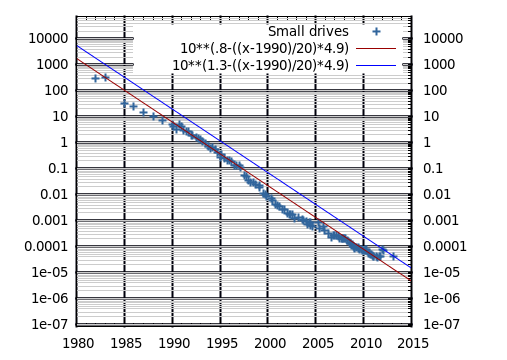Historical Cost of Computer Memory and Storage
Computer storage, primary and secondary memory, has seen a tremendous phase of development over the last fifty years. As new technology has been brought to the market prices have continued to decline steadily at a logarithmic scale. For magnetic storage, the trend has been very stable over the last thirty years, with prices per MB going down around a third every year, or a ninety percent every five years. For primary storage, the trend has been more volatile, but overall we see a similar rate of decline all the way back to the first flip-flops in the 1950s.
John C. McCallum has done a good job collecting all the data over the years, and going back to computer magazines for reference. However, since the beginning of 2012 there have been no updates, so I’ve taken up the work where he left off. I've added a new page to my site, where I will collect the data and update the graphs over time: hblok.net/storage

(Click image for larger version)
In the first update, the harddisk prices are most interesting, and we can now clearly see the effect of the flood disaster in late 2011. It has interrupted a thirty year trend, and as a result prices are about the same per MB as they were one and a half years ago. Now the question is, will this have a lasting effect on the magnetic harddisk prices, or will it be just a blip in history, as technological improvements bring us cheaper storage at the same phase.
The two plots below extrapolate the trend over the last thirty years, with two different scenarios: 1) Improvements in technology will catch up with the delay over the last year, and thus the thirty year trend will continue unaffected (red line). Or 2) phase of improvments will not change, and thus the rate of decline in price will stay the same, but shift the line by about a year (blue line).


(Click image for larger version)
The price is 4 cents per GB today (4e-5 per MB). If we look two years ahead, with the uninterrupted scenario (red line), the price would be 0.5 cents per GB in 2015 (5e-6 per MB), or put in different ways: 3 TB of storage which costs $125 today would have to go down to about $15 in two years, or for the same $125 you'd have to get a whopping 25 TB (yes, twenty five!). Given the recent news from the major harddisk vendors, that seems rather unlikely to happen; they're only planning for 5 TB drives at the end of this year. So, over two years time, prices will not catch up. Perhaps this will change looking even further ahead, however, extrapolating technological trends beyond a year or two is merely guessing.
If we look at the second scenario, where we assume that the prices will continue to decline at the same rate as they have done in the past, given today's price we're then looking at about 1.5 cents per GB (1.6e-5 per MB). That would mean that today's 3 TB would go for around $50, while $125 would buy you about 8 TB. That seems more reasonable, and also in line with what products are being brought to market and in research right now. If the rumoured 5 TB Western Digital disk will be realised with four platters (4 * 1.25 TB) at the end of this year, it means five platter 6.25 TB (5 * 1.25) disks are already a possibility. Increasing storage density another 30% to reach 8 TB over the following year seems a reasonable assumption.
Edit: A previous version of this article placed the decimal point for price per GB incorrectly, at 0.4 cents rather than 4 (although the other numbers were unchanged, as were the extrapolated predictions).